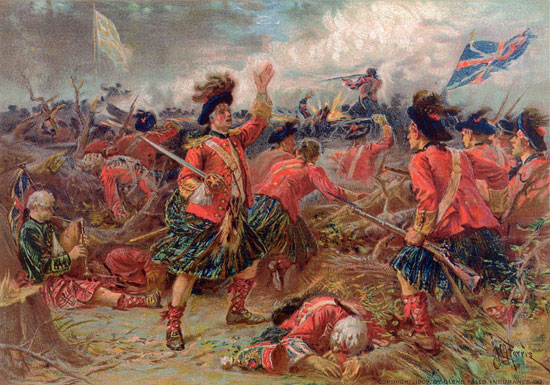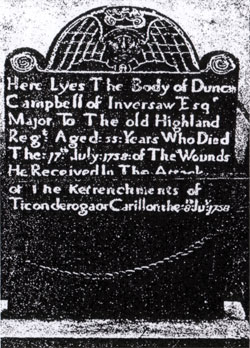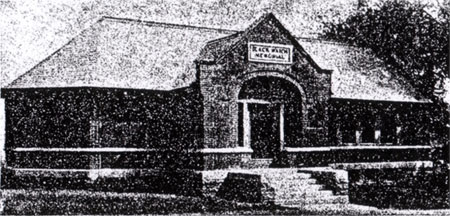| |

THE Glens Falls Insurance Company's historical calendar for 1904
dealt with the subject of Abercrombie's Expedition against Fort Ticonderoga,
July, 1758, the most imposing martial aggregation known to the New World
up to then. Its more than 6,000 British regulars and about 10,000 provincials,
with artillery train, munitions and equipment, gathered at the head of Lake George and
started down the lake July 5th – a splendid pageant.
Abercrombie was without antecedents or ability for the command, and after Lord
Howe (" the noblest Englishman of his time," second in command and the controlling
spirit), fell at the first fire of the first encounter with an advance French detachment, all
was hesitancy, indecision and folly.
Montcalm, with less than 5000, half French regulars, industriously profited by
Abercrombie's delay in strengthening his outlying defenses; throwing up earth and log
breastworks, felling forest trees outward and sharpening their branches, making an intricate and difficult abatis.
|

GRAVE OF MAJOR CAMPBELL
IN THE CEMETERY BETWEEN
GLENS FALLS AND FORT EDWARD, NEW YORK.
The inscription was so worn that it was "chalked"
for photographing.
|
July 8 Abercrombie hurled his solid columns against the entrenched French and
for six hours they fought with unsurpassed but unavailing valor. Seldom has life and
courage been more unreasonably wasted. The English loss was quite 2,000 and that of
the French about 500.
Under Abercrombie was the
famous " Black Watch," the 42nd,
and for valor at Ticonderoga designated by King George II. the
"Royal Highland Regiment." This
regiment, conspicuous in all of
England's wars for 170 years,
fought the fiercest of its many
battles at this time, with a loss
quite equal to that of any single
regiment in any single engagement
of history.
Writing of this battle at the
time, Lieutenant William Grant of
the " Black Watch " said: "The
attack began at a little past one
in the afternoon, and at two the
fire became general on both sides.
It was exceedingly and without intermission, in so much that
the oldest soldiers never saw so
furious and so incessant a fire.
Fontenoy was nothing to it – I
saw both.****
"The difficult access to the
enemy's lines was what gave them
fatal advantage, They had taken
care to cut down monstrous large
trees, which covered all the
ground from the foot of their
breastworks about a cannon shot
in every direction in their front.
This not only broke our ranks, but
put it entirely out of our power: to
advance until we had cut our way
through. I had seen men behave
with courage before that day, but
so much determined bravery can
scarcely be paralleled."
Other accounts mention the
"Black Watch" as hewing their
way with their broadswords
through the tangled branches of
the felled trees under a terrible
musket and artillery fire; some
even reaching the works, and the
actual entering by Captain John Campbell, "one of the two 'Black Watch' soldiers
presented to George II.," with a few followers, to be dispatched by French bayonets.
There is also the story of a Highland piper "continuing to play his bagpipe
after the loss of a leg." It is also said that " the Highlanders were so obstinate that
not 'till the third order of the general did-their commander get them to withdraw."
The loss of the "Black Watch" was 8 officers, and 297 rank and file, killed
and l7 officers, and 306 rank and file, wounded, – a total of 647l.
Among the officers - "displaying great valor" was Major Duncan Campbell of
Inverawe, who, according to a tradition of song and story, had been warned of his death at
an unknown place named Ticonderoga by the ghost of a murdered cousin whose slayer
he unwittingly sheltered; but, while wounded at Ticonderoga, he died at Fort Edward
nine days later, and his grave is in the cemetery between Glens Falls and Fort Edward,
near that of Jane McCrea.

BLACK WATCH MEMORIAL BUILDING, Ticonderoga, N. Y
CHRONOLOGICAL HISTORY OF THE "AM FREICEADAN DUBH," OR
"BLACK WATCH" REGIMENT.
1739 – Regiment organized.
1743 – Embarked for Flanders.
1735 – Battle of Fontenoy.
Battle of Preston Pans.
1746-7 – Served in North America and
Flanders.
1756 – Embarks for North America.
1758 – Attack on Ticonderoga.
Granted distinction of "Royal Highland Regiment."
1759 – Attack on Martinique.
Capture of Guadeloupe.
Second battalion embarks for North
America.
Second attack and capture of Ticonderoga.
1760 – Capture of Montreal.
1762 – Capture of Martinique.
Capture of Havana.
Embarks for North America.
1763-4 – Employed against Red Men.
1767 – Embarks for Ireland.
1770 – Embarks for North America.
Battle of Brooklyn.
Capture of Long Island.
Siege of Fort Washington.
Affair at Pisquata.
Battle of Brandywine.
Battle of Germantown.
1779 – Capture of Stony Point and Vereplank.
1780 – Siege of Charlestown.
1Z81 – Second battalion embarks for West
Indies.
1783 - Removed to Nova Scotia.
1789 – Return to England.
1793 – Served in Flanders.
1795 – West Indies again.
|
1796 – Capture of St. Lucia.
1798 – Capture of Minorca.
1801 – Battle of Aboukir Bay.
Battle of Alexandria Bay.
1802 – Portugal.
1809 – Battle of Corunna.
Expedition against Holland.
1812 – Siege of Ciudad Roderigo.
Siege of Badajoz.
Battle of Salamanca.
1815 – Battle of Vittonia.
Battle of Pyrenees.
Battle of Nivelle.
1814 – Battle of Toulouse.
1815 – Battle of Quartre Bras.
Battle of Waterloo.
1854 – War of the Crimea.
Battle of the Alma.
Battle of Balaklava.
1856 – Fall of Sebastapol.
1857 – Battle of Cawnpore.
1858 – Relief of Lucknow.
1868 – Return to Edinburgh.
1873 – Expedition against Ashanti.
1874 – Capture of Borborassie, Amoaful.
Becquah, Ordahan and Coomassie.
1882 – Battle of Tel-el-Kebir.
1884 – Battle of El Teb.
Capture of Kirbekan.
1898 – Battle of Khartoum.
1899 – South Africa, "Magersfontein"
|
Back to the Stories of the French & Indian and Revolutionary Wars. |


